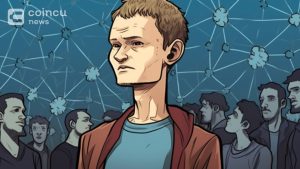Ethereum 2.0 upgrades are not a game changer that can bring in more users
Ethereum 2.0 (Eth2) is connected to the so-called Messiah blockchain from Ethereum. Newsflash: it is not. The long-awaited changes are expected not to address the core issues that plague the network and hinder wider adoption.
Vitalik Buterin, the brilliant mastermind behind the Ethereum blockchain, sees the staff working with Ethereum as a bigger problem than the actual software, as he said in a recent interview with Forkast News. While the staff working on the project may or may not have problems, this is certainly not the only shortcoming. It seems that the promise of a new implementation, the type of software upgrade, will not solve the long-term problems that have brought the network to the heights that Buterin and his disciples envisioned.
Connected: The Great Tech Migration: The Ethereum Blockchain Is The New San Francisco
Main problems
Ethereum is currently running on a Proof-of-Work (PoW) system that only allows up to 15 transactions per second or so – twice as much as the Bitcoin (BTC) blockchain – and viewed by many as impractical for scalable decentralized finance – or DeFi ecosystem. Therefore, the gas fees at Ethereum are very high. Since very few transactions can be processed per second, the prices for faster processing become competitive. Research by Dune Analytics shows that 2-5% of transactions on Ethereum-based decentralized exchanges (DEXs) fail due to complications such as inadequate gas prices.
Connected: Ethereum fees are skyrocketing – but traders have alternatives
Another core problem with the Ethereum platform, but one that is often overlooked, is the poor user experience (UX) design. As a result, average users who might be interested in participating in Decentralized Financial Applications (DApps) or Unavailable Token Markets (NFTs) will avoid this because the user interface is not only unintuitive, but also does not have sufficient educational resources for users to know how to use the platform.
Users are expected to set transaction fees in gas prices and limit the gas used for transaction processing. However, how many actual users know this without delving into the wild hole of crypto terminology and information? Insider Intelligence reports that 25% of adults in the US either don’t understand or don’t know how to invest in digital currencies. How can a user without access to effective educational tools know that sending payments from two separate wallets to the same receiving address will not cause a conflict? In all likelihood, the vast majority of normal users would be unaware of such a problem.
Connected: The mass adoption of blockchain technology and education is key
Ethereum 2.0
To address these long-standing issues, Ethereum’s custodians announced the launch of Eth2 as a series of upgrades over its existing model, including a move to Proof of Stake (PoS) and sharding. The proof-of-stake concept states that people can mine blocks and validate transactions based on how many coins they own. The Ethereum Foundation has announced that the transition to PoS should be completed by the end of 2021. As the Ethereum Foundation recently stated in a blog post, the “energy demand remains unchanged” compared to the old PoW system.
Connected: When will Ethereum 2.0 fully launch? Roadmap promises speed, but history says otherwise
Sharding is expected to take even longer, and according to the Ethereum website, “shard chains depending on how fast the work is going” could be shipped around 2022 once the Ethereum mainnet is out. in the merger with the Beacon Chain Proof of Stake system. Sharding is the process of horizontally sharding a database to balance the load, reduce network congestion, and increase transactions per second. The shard chains are intended to give Ethereum more options to store and access data.
The new upgrades are said to be more environmentally conscious and to speed up the processing of transactions. In addition to these upgrades, the blockchain programming language is expected to change from the traditional Ethereum Virtual Machine (EVM) to one that can be adopted by developers using C ++ or Rust, simplifying programming right in the browser. While infrastructure upgrades can provide benefits in some areas, such as improved transaction processes, they still fail.
First, Ethereum 2.0 has been around for years and many users are wondering when the full upgrades will actually take place. The proof-of-stake aims to reduce mining costs and energy consumption, but network throughput will only increase if the block time is reduced and / or the block size is increased. In addition, sharding only allows applications to run independently and only need to be synchronized once. However, the inherently decentralized and open source nature of DeFi means that sharding must execute transactions over a relay chain, thus slowing down the whole process.
Connected: Where does DeFi’s future belong: Ethereum or Bitcoin? Experts answer gia
More importantly, Ethereum is still lagging behind in a large part in terms of user experience, which the launch of the Eth2 upgrade did not fix. While Ethereum claims it will release upgrades to handle transaction processing speeds and high gas fees to some extent, the platform shows a blatant disregard for issues that, if resolved, will open the door to large numbers of users who are currently unfriendly from Ethereum’s interface.
Even if the upgrades are expected to roll out at some point, users will still struggle to set transaction fees in gas prices and gas limits for transaction processing. Outside of Ethereum, too, UX problems are not unique to Ethereum and often occur with other blockchains that use the EVM protocol, such as: With other Ethereum-compatible chains using the EVM protocol also suffering from similar UX issues, it is difficult to imagine a future where even EVM-based chains will really be accessible to ordinary users.
In addition to persistent problems with gas charge specifications, transactions with long confirmation times often result in delays, confirmation messages, and asynchronous sending of transactions. Often times, users do not receive confirmation immediately after the transaction, which leaves too much uncertainty as to whether the target recipient will receive the transaction. For users who are used to instant results on the web like ecommerce scenarios, this is a strange and frustrating user experience.
Ethereum may be the darling of the blockchain world, but at some point the hype can turn into hot air and chances are the long-awaited upgrade won’t find widespread acceptance. It is unclear whether the expected changes can keep the promises made by the head of the Ethereum Foundation. Until Ethereum can solve some of the deeper problems, there is no doubt that Eth2 will make a significant difference to anyone outside of the Ethereum enthusiast community. At the moment, Ethereum 2.0 is not a necessary game changer, but an aesthetic upgrade.
Adrian Krion is the founder of the Berlin blockchain game startup Spielworks with a background in computer science and mathematics. After starting programming at the age of 7, he has been successfully bridging the gap between business and technology for over 15 years and is currently working on projects that connect the emerging DeFi ecosystem with the gaming world.
.
.


















